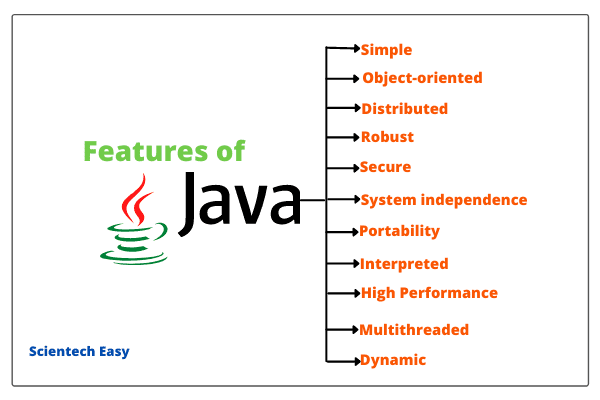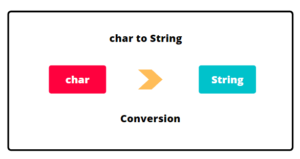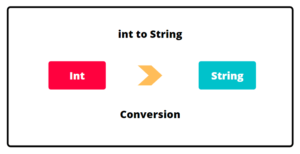Features of Java | Java Buzzwords
In this tutorial, we will learn about all the basic and advanced features (also known as buzzwords) of Java programming language.
We know that Java is an object-oriented and platform-independent language. In addition to these two popular buzzwords (features), there are also several other important features of Java that we need to know.
Understanding these features is essential because the history and evolution of Java cannot be complete without a look at the features of Java. Therefore, it is important to know Java buzzwords because they played significant roles in modeling Java language.
Features of Java Programming Language
There are a total of 11 features of the Java programming language, which are listed below:
- Simple
- Object-oriented
- Distributed
- Robust
- Secure
- System Independence
- Portability
- Interpreted
- High Performance
- Multithreaded
- Dynamic
Let’s understand each Java feature one by one.
1. Simple
Java is designed as a simple programming language. When Java was developed, the Java team wanted it to be simple for the professional programmer to learn and use effectively. This was important because Java had to run on a variety of electronic devices, including small machines, where less memory is available. At that time, the size of basic interpreter and class support is only 40 KB.
Now, the question arises here: how was Java made simple?
First of all, several difficult, clumsy, and confusing features found in other programming languages such as C and C++ were omitted in Java. For example, the feature of pointers which is often very difficult for both beginners and experienced programmers. Therefore, this feature had been completely eliminated from Java.
Second, the JavaSoft team maintained the same syntax of C and C++ in Java so that a programmer who knows C or C++ will find Java already familiar and require very little effort in learning.
Why Pointer feature is eliminated from Java?
There are mainly three reasons to eliminate the pointer concept from Java. They are as follows:
- The concept of Pointer leads to confusion for a programmer.
- Pointer may break a program easily. For example, when we add two pointers, the program can crash immediately.
- The use of Pointer feature can break security because harmful programs like virus and other hacking programs can be developed using pointer.
Because of the above reasons, the pointer feature has been completely eliminated from Java technology.
2. Object-oriented
Java is a purely object-oriented programming language (OOP). This means that Java programs are developed by using classes and objects. In other words, to write a program in Java, we need at least one class or an object. Now, the question is:
What is an Object in Java?
An object is anything that exists in the real world. For example, every human being, a book, a tree, pen, pencil, and so on. Every object has properties (attributes) and shows certain behaviors (actions). Let us understand this statement with the help of an example.
Consider a dog. The properties of a dog are name, height, color, age, etc. These properties are represented by variables in Java. The object dog has several behaviors (actions) such as running, barking, eating, sleeping, etc.
These behaviors or actions are represented by various methods (functions) in Java programming. So, we can say that an object contains variables and methods that define its properties and behavior.
The second question is:
What is a Class in Java?
A class defines the name of a group given to several objects having the same properties and behaviors (actions). Let’s understand this statement with the help of examples.
Example 1:
Consider a mobile phone. A mobile can be the brand name of Samsung, Nokia, Motorola, and Vivo. All these four mobiles show the same functions (behaviors) such as messaging, calling, internet surfing, etc. Hence, they will belong to the same group called Mobile. In this case, the class name is Mobile that contains four objects. In other words, Mobile is the class name, and Samsung, Nokia, Motorola, and Vivo are its objects.
A class in Java can be defined as a model or a blueprint for creating objects. We write the properties and actions of objects in the class: “Mobile”. This means that a class can be defined as a model in the creation of objects. Just like an object, a class contains:
- Variables (to define properties)
- Methods (to define actions)
Look at the below figure to better understand the concepts of classes and objects.
Example 2:
Flower is a class and if we consider Lily, Rose, and Jasmine, these are all objects of class “Flower”. The class Flower does not exist physically but its objects such as Lily, Rose, Jasmine exist physically in the real world.
Note: C++ is not a purely object-oriented programming language because it is possible to write programs in C++ without using a class or an object. C++ supports both procedural and object-oriented programming paradigms.
3. Distributed
Java is designed to support the distributed environment of the Internet because it has built-in support to handle TCP/IP and UDP protocols.
Using Java, we can make a program to get information and can distribute it on various computers on a network. Java also support a feature called Remote Method Invocation (RMI) that enable a program to distribute methods across a network.
4. Robust
The meaning of Robust is “strong”. In the context of programming, it means that Java programs are strong and reliable because they do not crash easily like C or C++ programs.
There are three main reasons why Java is considered a robust programming language:
a. Exception Handling
Java has an excellent inbuilt feature named exception handling. An exception is an abnormal condition or error that occurs at run time. If an exception occurs in a Java program, the program terminates abruptly and rises to problems like loss of data.
To overcome such types of problems, we can use exception handling mechanism. This means that even though an exception occurs in a program, no harm (i.e. loss of data) will happen. The program can gracefully handle errors without crashing and can continue running or shut down safely.
b. Robust Memory Management
Second reason is that Java has a robust memory management feature. Most of the C and C++ programs crash in the middle because of not allocating sufficient space in the memory for a program.
Such problems will not occur in Java because we do not need to allocate or deallocate the memory in Java. Everything is taken care of by Java Virtual Machine (JVM) only. For example, the JVM allocates the required memory for a Java program and automatically reclaims unused memory using Garbage Collection. This reduces the chances of memory-related errors.
c. Error Checking at Compile-Time and Runtime
Third reason is that Java supports an error checking feature at various stages: Early checking at compile-time and dynamic checking at run time.
- Compile-time checking can catch many errors before the program runs.
- Runtime checking handles issues that arise during program execution.
This multi-level error checking system makes Java more reliable and less prone to crashes, contributing to its robustness.
5. Secure
Since Java supports the distributed environment of the internet, it also provides multiple built-in security features. While using Java over the Internet, these features help protect Java programs from security problems or threats, such as:
- Tampering (unauthorized code modification)
- Impersonation (identity spoofing)
- Virus threats (malicious code execution)
Java is widely used in network-based applications, so security is a core part of its design. Below are the key security mechanisms Java provides:
- Bytecode Verification
- ClassLoader Mechanism
- Security Manager and Access Control
- Java Security Package
- Code Signing and Certificates
Because of these features, Java provides a secure platform for developing and running distributed applications, especially those accessed over the Internet.
6. System Independence (Architecture Neutral)
The Java compiler compiles the source code into bytecode, which is independent of any specific machine architecture. In other words, the bytecode of Java program is not machine-dependent. It can be run on any system machine regardless of any processor and operating system that implements Java Virtual Machine (JVM).
The original goal of JavaSoft was to “write once; run anywhere, any time, forever”. To a great extent, JavaSoft successfully accomplished this goal, making Java one of the most portable programming languages available.
7. Portability
If a program gives the same result on every system or machine, that program is called portable. Java programs are portable because the Java compiler translates the program into platform-independent bytecode. This bytecode can run on any system that has a Java Virtual Machine (JVM).
8. Interpreted
During compilation, Java compiler converts the source code of the program into bytecode. This bytecode can be executed on any system or machine with the help of the Java interpreter, which is part of the Java Virtual Machine (JVM).
If we take any other programming language, only a compiler or an interpreter is used to run programs. But in Java, both compiler and interpreter are used for the execution of the program. Java interpreter within JVM reads and executes the bytecode line by line at runtime. This is why Java is often referred to as an interpreted language.
9. High Performance
The speed of interpreter inside JVM to execute a program is relatively slow because it processes bytecode line by line.
To overcome this performance issue, JavaSoft team has introduced JIT (Just-In-Time) compiler which significantly improves the performance of interpreting byte code by caching interpretations.
The JIT compiler translates the bytecode into native machine code at runtime and caches it for future use. This reduces the need for repeated interpretation and enhances the overall execution speed of Java programs.
Consequently, both the interpreter and the JIT compiler inside the JVM work together to achieve efficient, high performance execution of Java programs.
10. Multithreaded
Java supports multi-threading programming that allows to write programs to do several works simultaneously. A thread is an individual process to execute a group of statements.
JVM utilizes multiple threads to execute different blocks of code. It can manage and execute multiple threads at the same time, enabling efficient use of CPU resources. Creating and managing multiple threads in Java is called multi-threading. A program that uses this feature is called multithreaded program.
11. Dynamic
Before the development of Java, only static text or content was displayed on the browser. But using applet program, we can also create and display dynamic content, such as animations and interactive features directly in the browser.
Conclusion:
In this tutorial, we have provided a clear and detailed explanation of the key features of Java, along with real-time examples to understand them better. I hope that you have now a solid understanding of the core features and strengths of Java technology. In the next tutorial, we will dive the JDK (Java Development Kit) in a simple words.











